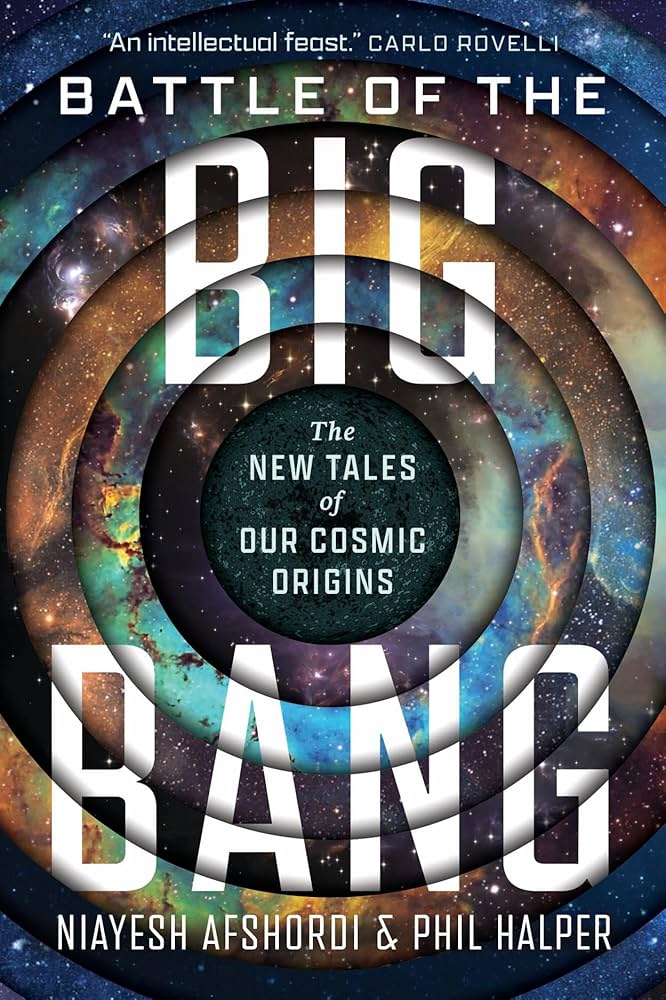Battle of the Big Bang
October 8, 2025

The book The Battle of the Big Bang is about various scientific theories that attempt to explain how the universe came to be. When you hear this, you might be surprised and think to yourself: isn’t it clear how our universe came to be? First, there was the singularity, with infinite density, infinite temperature, and so on. Then came the Big Bang, where the singularity rapidly expanded — a phase called inflation. Roughly 13 billion years later, here we are.
But things are not as simple as they seem. Let’s first look at why people in the scientific community think otherwise.
Penrose and Hawking together formulated an influential theory, later known as the Penrose–Hawking singularity theorem, which supposedly proves an absolute beginning of time. But like any mathematical proof, it relies on several assumptions:
- Gravity is always attractive.
- The universe has three spatial dimensions and one time dimension, which we can measure with rulers and clocks.
- Time travel into the past is impossible.
- Einstein’s theory of general relativity describes the evolution of the universe at all scales.
The first assumption is challenged by cosmological observations, which show that the expansion of the universe is accelerating. Meanwhile, both Penrose and Hawking have questioned the second assumption, suggesting that the fundamentals of physics might not be the same as the world familiar to us. Penrose argues that, at the beginning, the universe was too hot to define rulers and clocks, while Hawking claims that time itself is emergent and not a fundamental aspect of physics.
Finally, the fourth assumption is almost certainly incorrect because it contradicts quantum theory, which governs how particles behave on the smallest scales.
In other words, the theorem that scientists relied on to argue for a beginning of the universe rests on several shaky assumptions.
If the universe didn’t start with a Big Bang, what then? The honest answer is: we don’t really know. There are many competing theories, each with advantages and disadvantages. Some believe the universe is cyclic, instead of a Big Bang, there is a “bounce.” Others propose the “Big Rip,” in which the universe tears itself apart and is reborn. Some theories suggest the universe is past- and future-eternal. Others propose that it arose through a process of cosmic natural selection, or that it emerged through quantum tunneling from literally nothing. And there are many more possibilities.
Personally, aesthetically, I like the ekpyrotic model best. Not only is it poetic, it also pays homage to the first philosophers, such as the Stoics and Heraclitus, who proposed a similarly named model:
“As a consequence of this, so our school believes — though it used to be said that Panaetius questioned the doctrine — there will ultimately occur a conflagration of the whole world. When the moisture has been used up, neither can the earth be nourished nor will the air continue to flow, being unable to rise upward after it has drunk up all the water. Thus nothing will remain but fire, by which, as a living being and a god, once again a new world may be created and the ordered universe be restored as before.” — Cicero, De Natura Deorum II (section 118)
But what exactly is this model, in the words of the book?
“In the ekpyrotic model, two high-dimensional branes collide. The energy of the collision becomes matter and radiation, triggering our Big Bang. In phase A, the branes of a cold, diluted universe approach each other; in phase B, they collide and heat up; in phase C, they expand away from each other. […] This model truly inherits the spirit of the original ekpyrotic universe of the ancient Stoic philosophers. It would be cyclic, repeating endlessly as the branes smashed into each other, creating an inferno to cleanse the universe.”
Though I dislike its reliance on string theory — as Nobel laureate Sheldon Glashow famously said, string theorists’ work is so removed from reality that it should be compared to medieval theologians pondering how many angels can dance on the head of a pin — the model is compelling aesthetically.
But just because I like the story doesn’t mean it’s true. I’m only saying that if one of our stories about how the universe came to be turns out to be correct, I hope it’s this one.
Why does it matter how exactly the universe came to be? Or, in the words of the author: “Do we really need a story — yet another creation myth?”
In both religion and philosophy, we often make arguments that rely on implicit assumptions about how our universe functions and how it began. I want to mention two examples.
The first is the fine-tuning argument, which goes like this:
- The fine-tuning of the universe is due to either physical necessity, chance, or design.
- It is not due to physical necessity or chance.
- Therefore, it is due to design.
This argument relies on the uniqueness of our universe. But this assumption is only weakly supported under the Big Bang model. For example, if our universe were produced through cosmic natural selection, and our human living conditions were a byproduct, it would be unsurprising that life-supporting conditions exist. If we instead believe in inflationary theory, the existence of a multiverse is a generic prediction i.e. most inflation-based models predict a multiverse. In a cyclic universe, what makes us unique if each cycle is a “retry”? In both cyclic and multiverse theories, a universe capable of supporting humans is bound to happen eventually.
Proof: if one has infinite tries, everything that can happen will happen
<p>Let (E) be an arbitrary event of a single trial.</p>
Suppose the trials are independent. Let (A_n) be the event that (E) occurs at least once in the first (n) trials. By independence:
$$ P(A_n^c) = (1 - p)^n $$Hence:
$$ P(A_n) = 1 - P(A_n^c) = 1 - (1 - p)^n \leq 1 - (e^{-p})^n = 1 - e^{-pn} \to^{n \to \infty} 1 - 0 = 1 $$Thus, with infinitely many trials, the probability of (E) occurring at least once converges to \(1\).
The second is the cosmological argument, which goes like this:
- Whatever begins to exist has a cause.
- The universe began to exist.
- Therefore, the universe has a cause.
This argument relies on the Big Bang singularity proving a beginning of time — which many physicists deny. It is also unclear whether it makes sense to speak of causation at the beginning of the universe, since causality might be an emergent property, absent at fundamental scales. Moreover, there are models of past-eternal inflation in which premise (2) would be false.
A related type of argument is infinite regress, in which some chain of causes is claimed to extend infinitely into the past, and is therefore rejected. But as we have seen, there are plausible models of past-eternal universes, where infinite regress is not only possible, but natural.
Lastly, how the universe came to be is part of the story of us humans: how we see ourselves and understand our place in the world. We do not live in a purely objective, fact-based world; we live and breathe in stories. And how the universe came to be is probably the biggest and greatest story of them all.
So, to answer the question: why does the beginning of the universe matter? Not only do many philosophical arguments depend on how this question is answered, but it is also an integral part of human identity.
